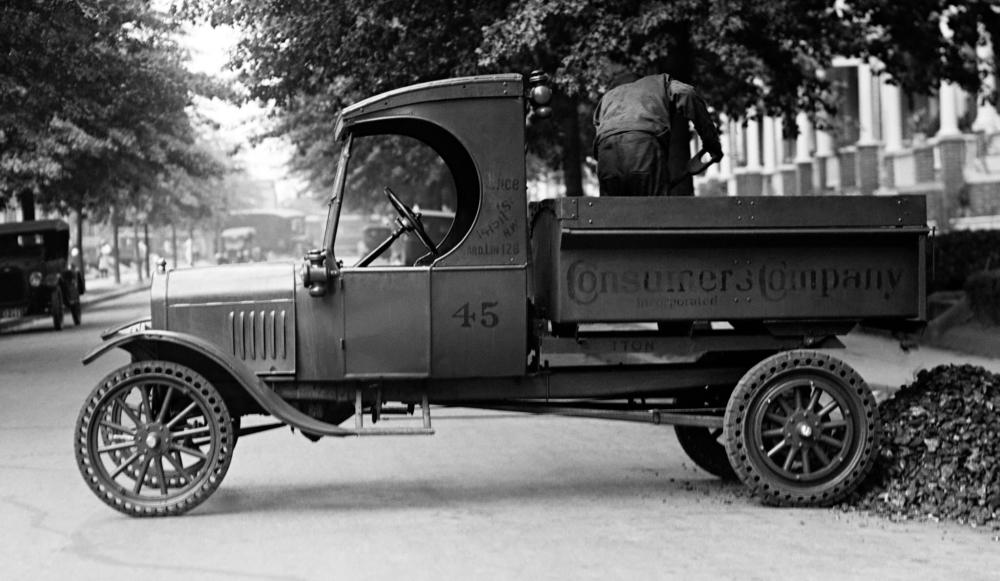
Long before the Ford F-Series was introduced in 1948, Ford was producing and selling trucks. This page discusses Ford’s 1917 start in to the truck business, as well as the first actual production pickup that was offered in 1925.
1917-1927 Ford Model TT
After the introduction of the Model T in 1908, coach builders began to adapt it for commercial purposes, adding stake beds and enclosed bodies to carry cargo. Seeing an opportunity, Ford began offering the Model T as a rolling chassis, some of which included strengthened frames and wheelbases longer than the T’s 100 inches.
By 1914, third-party suppliers were building heavily modified versions of the Model T chassis capable of hauling up to three tons of cargo. The company began to receive more requests to build a heavy-duty platform of its own, but Henry Ford found himself distracted by several projects, including the development of Fordson tractors and a December 1915 trip to Europe to negotiate an end to the first World War. His efforts in ending the war were unsuccessful.
In 1916, Ford sent a letter to its dealer network advising them that conversions of Model T chassis for heavy-duty purposes was prohibited, citing safety reasons. While this may have been a valid excuse, Ford itself was in the process of developing a one-ton truck chassis, and hoped to eliminate the competition prior to its launch.
Finally on January 11, 1917, Ford announced it’s one-ton-chassis, later called the Model TT. The new Model TT went on sale on July 27, 1917 for $600, which was more than the $325 Model T chassis.
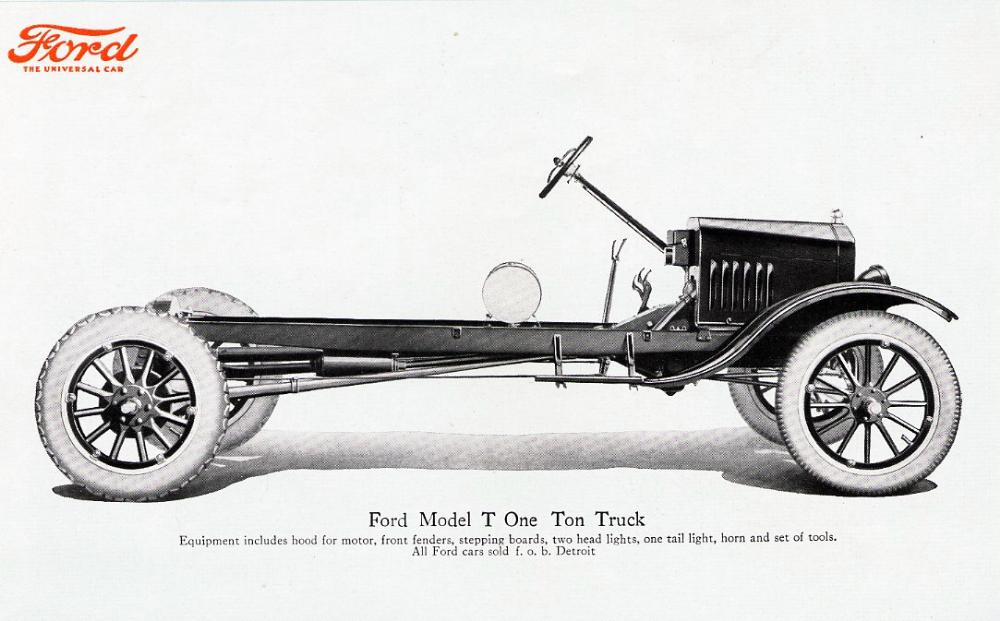
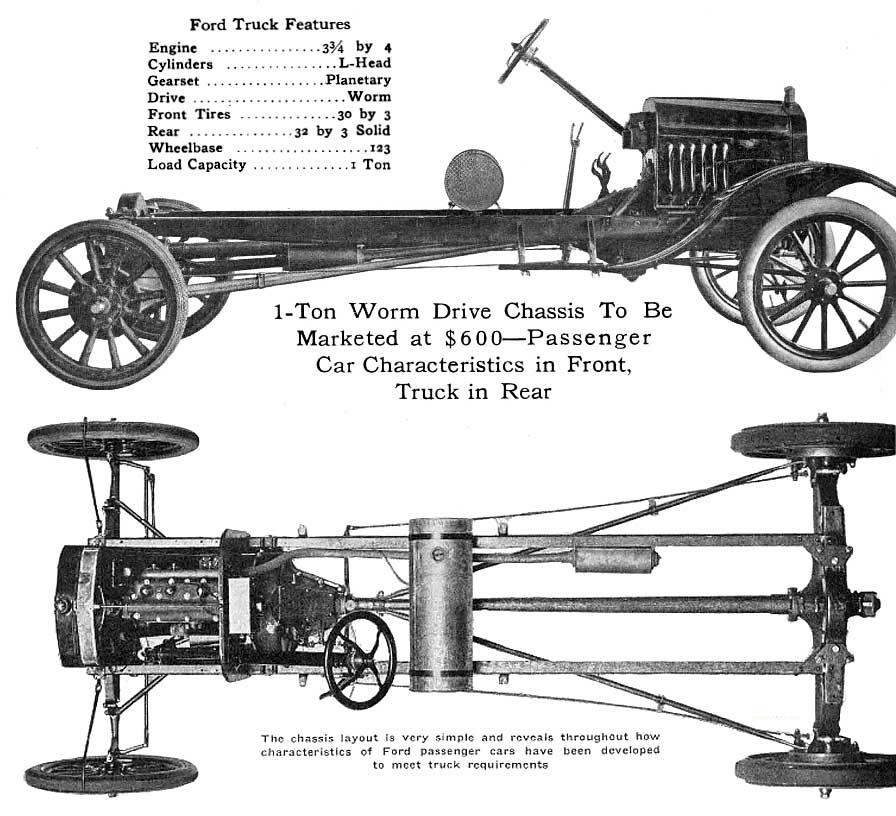
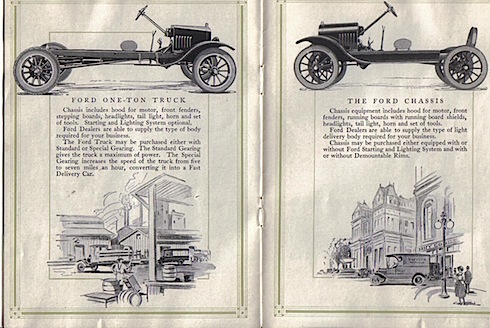
(Ford Model TT chassis on the left – Ford Model T chassis on the right)
For the $600, buyers received a truck chassis consisting of a reinforced frame stretched to a 124-inch wheelbase, a heavy-duty suspension, and a worm drive axle that could be ordered with either standard final gearing of 7.25:1 (delivering a top speed of 15 mph) or optional 5.17:1 gearing that allowed the Model TT to achieve the breakneck pace of 22 mph. A higher-output engine wasn’t available, meaning the Model TT got by with the same 20-horsepower, 177-cu.in. inline four-cylinder engine found in the Model T.
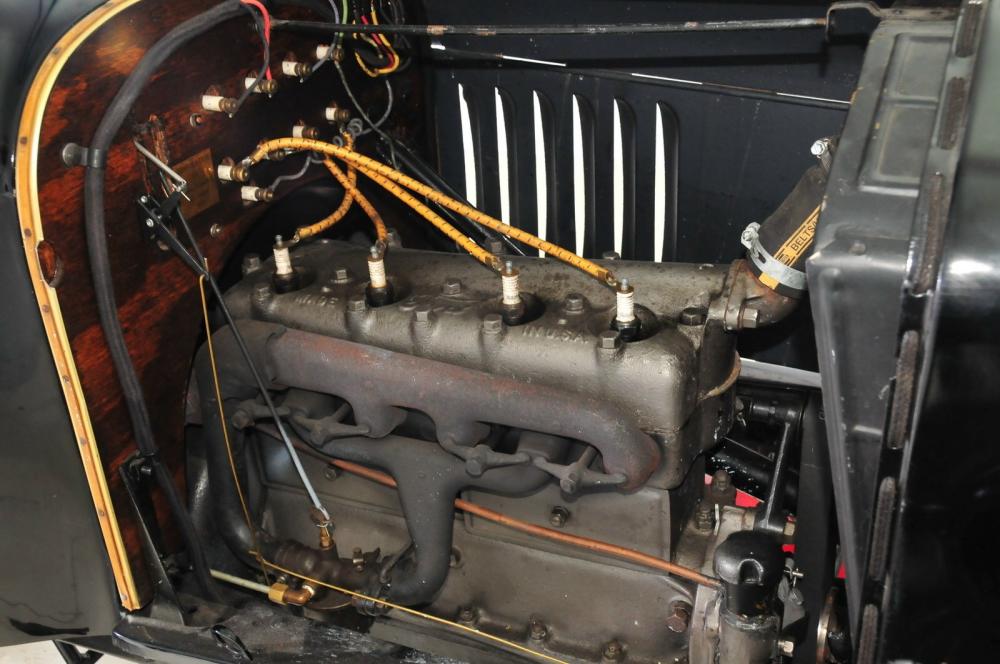
(Ford 177-cu.in. inline four-cylinder engine)
Many were also fitted with one of the few Ford Motor Company approved after market “conversions,” namely the Ruckstell rear end, which was an “Under-drive,” or granny gear, that reduced ratios even further to provide even lower ratios for tackling steep hills and muddy roads. Another significant difference between the TT and regular Ts were twin rear leaf springs, one per wheel, unlike regular Ts that had one set of cross beam leaf springs at both ends of the vehicle. The TTs rear wheels were also different from the front, with shorter, stouter, wooden spokes and wider, stronger, tires.
Though pneumatic tires were fitted to most cars by this time, many trucks had solid rubber tires on the rear to allow for higher load capacity. But these produced a brutally jolting ride, so some were “ventilated” with holes that went all the way through — from sidewall to sidewall — allowing the tread to flex a bit. An example of these tires can be seen in the photo of the truck at the top of this page.
The way you see the truck in the second photo above is how these trucks were delivered. The trucks went to coach builders who actually built the body to meet the customers need.
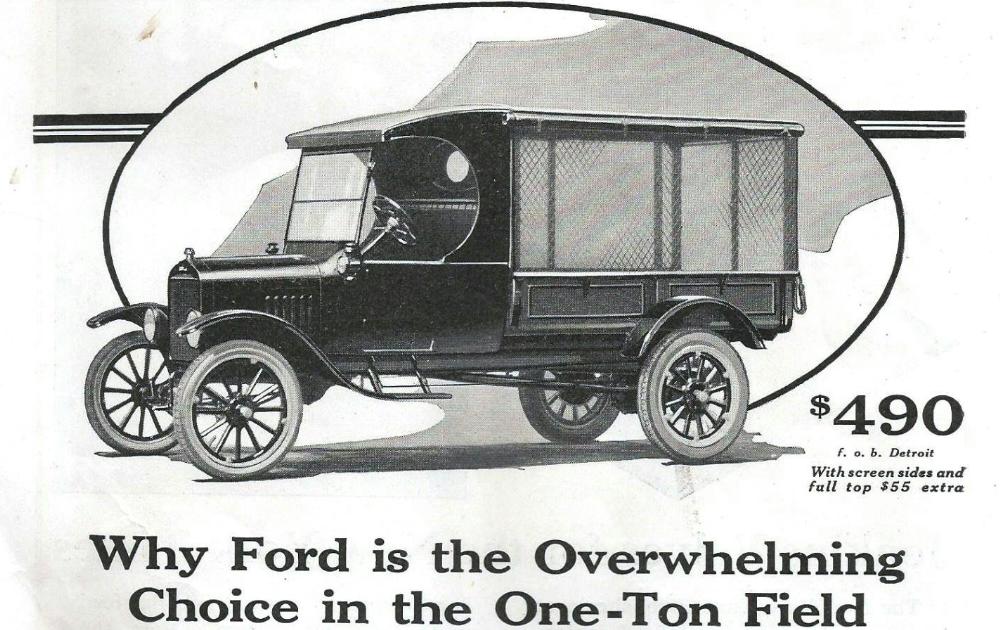
By 1920 over half the trucks in America were based on the Model T and most were owned by farmers. In 1924, sales were beginning to slip due to improving competition. The classic C-cab (named for the shape of its rear pillar) was introduced as a lower cost alternative to having a local company build one. The cabs were noisy, cramped and crude, lacking any creature comforts, while the metal beds were very shallow and not particularly sturdy. Neither was popular with folks who used the Model TT to make a living, especially while the bare chassis and engine combination was still available.
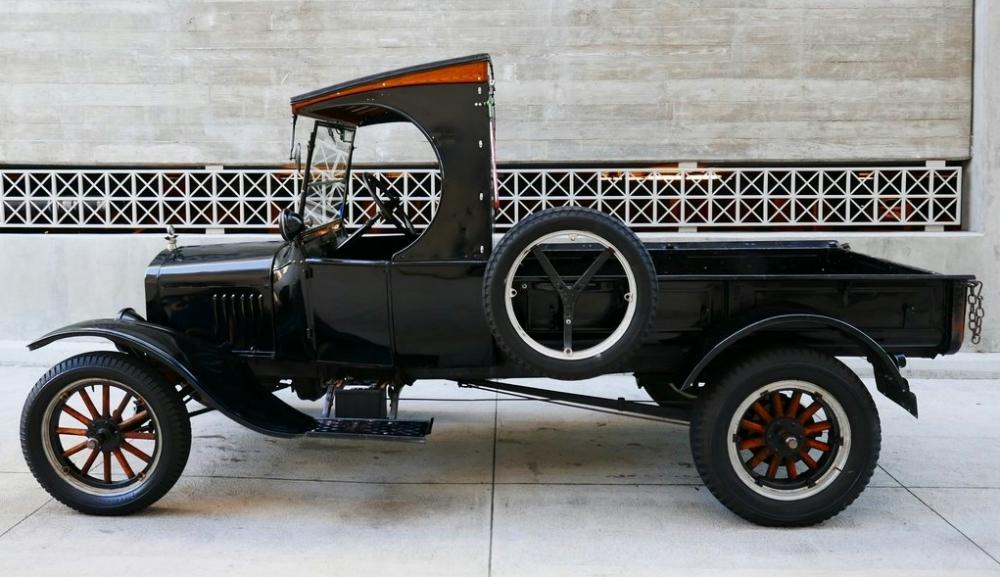
(1924 Ford Model TT C-Cab)
A factory built enclosed cab made out of metal finally became available in 1925, and the number of body offerings from Ford was increased. By the time that Ford’s 1.5-ton Model AA replaced the TT in 1927, total production had reached 1.3-million units.
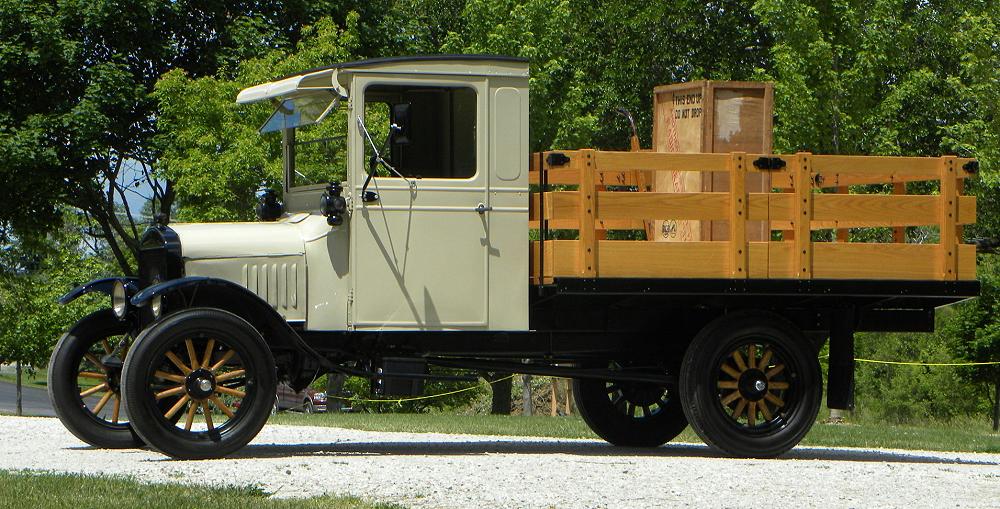
(1925 Ford Model TT with factory metal cab)
In 1914, a trailer was built for the Sibley Lumber Company by wagon builder August Fruehauf. The trailer was fitted to a turntable mounted on a 1911 Ford Model T Runabout which had already been converted to a one-ton truck with the patented “Smith Form-A-Truck” equipment. A quick indication that this is a ‘Form-A-Truck’ kit is the chain drven rear axle.
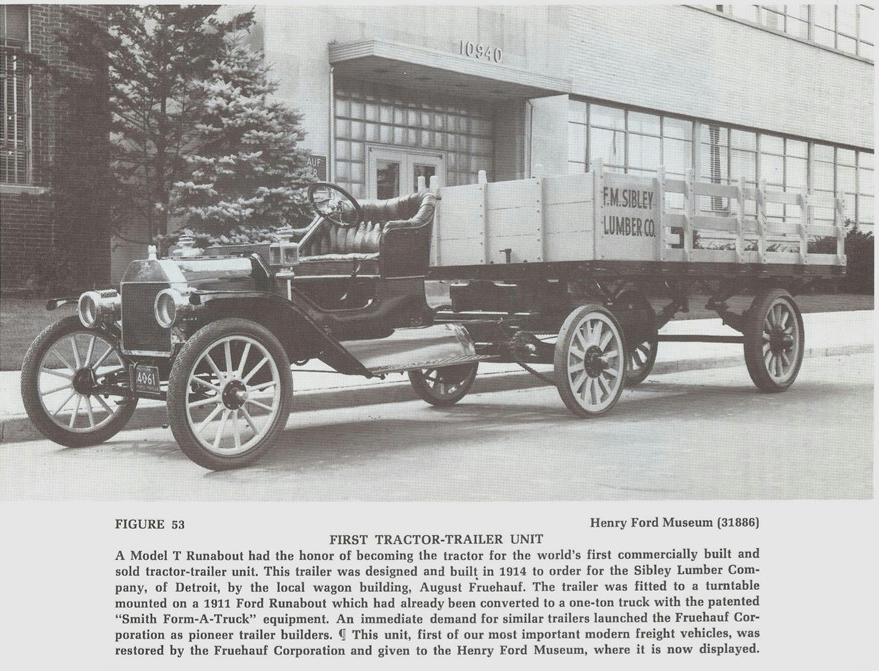
Model TT Production:
- 1917: 3
- 1918: 41,105
- 1919: 70,816
- 1920: 53,787
- 1921: 64,796
- 1922: 154,039
- 1923: 246,817
- 1924: 259,118
- 1925: 306,434
- 1926: 213,914
- 1927: 74,335
1925 Model T Runabout Pickup
On April 25, 1925, Ford released the Ford Model T Runabout with a pickup bed. This was the first time in American truck history that you could go buy a factory-built pickup. The pickup came with an all steel bed that was 56-inches long, 40-inches wide, and 13-inches high. The sides of the bed had pockets for stakes, and the tailgate was adjustable. Equipped with a four-cylinder 40 horsepower engine and heavy-duty leaf springs in the rear, the Ford Model T Runabout was priced at a reasonable $281. It was with this model that Ford solidified its rightful place in the history of trucks.
With the Ford Model T Runabout, Henry Ford revolutionized the truck. Instead of having to modify your car and add a truck bed, Henry Ford created the first official pickup truck that was ready straight from the factory. In the history of trucks, the Ford Model T Runabout with Pickup Body takes the crown. In the first year of production, Ford sold 33,800 pickups. Chevrolet didn’t start offering factory-made American pickup trucks until 1931.
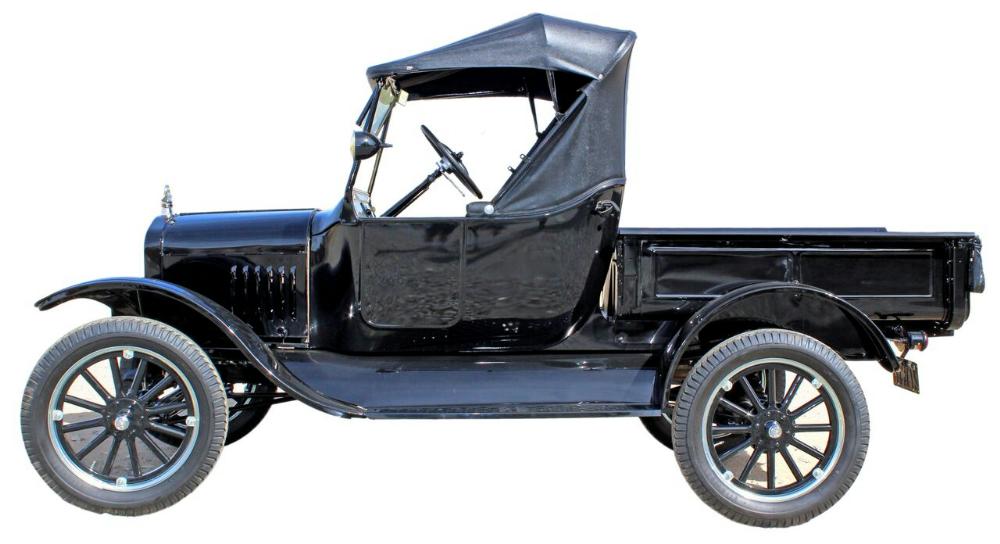
(1925 Ford Model T Runabout Pickup – First Production Pickup Truck)
1927-1931 Ford Model A and Model AA Trucks
As the Model T and TT became obsolete and needed to be replaced, Henry Ford began initial designs on the Model A and Model AA in 1926. Basic chassis layout was done rapidly and mechanical development was moved forward quickly. Body design and style was developed and then outsourced to various body manufacturers, including Briggs and Murray. The designs of the Model A shared parts and materials with the Model AA Ford, notably the body, engine and interior. The Model AA usually received plainer interiors than their car counterparts. The Model AA followed similar design changes to the Model A during the AA’s four years in production, often delayed anywhere from three to nine months. The mechanical changes and upgrades were done during production of the vehicles. Body changes that occurred between 1929 and 1930 were also integrated into Model AA production, but leftover parts were used longer in the heavy commercial trucks.
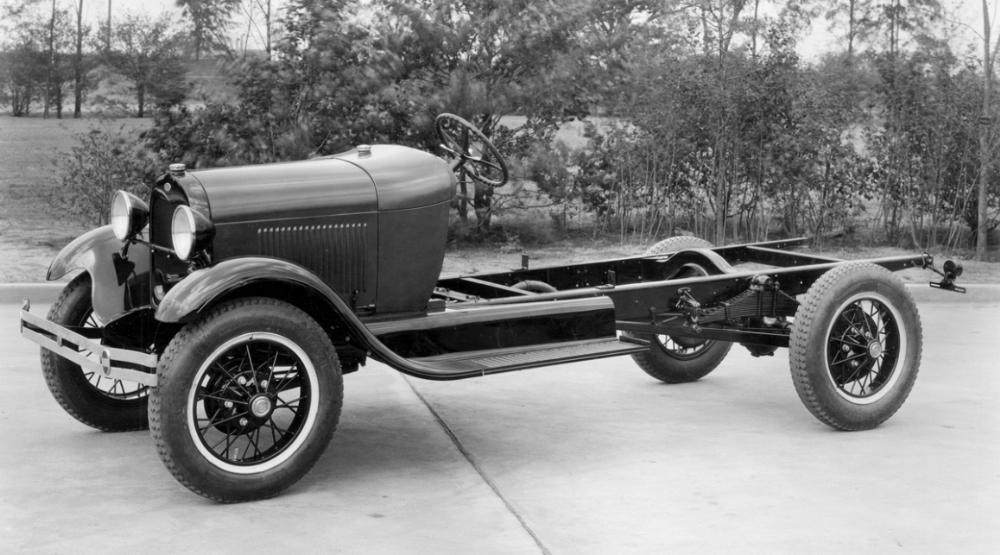
The Ford Model AA (1-1/2 ton truck) is powered by the same 201-cubic-inch (3.3 L) engine I4 engine that the Model A Ford used. The engine produced a maximum of 40 horsepower at 2,200 rpm. The engine featured an up-draft carburetor, six-volt generator, 2-blade fan, mechanical water pump, mechanical oil pump, electric starter and four-row radiator. All of these features were identical to the Model A Ford except the radiator. The engine could also be crank started if necessary by a hand crank that is inserted through a hole in the radiator shell. The Model AA was based on a chassis that was similar in design to the Model A Ford, except it was substantially larger and heavier to accommodate the work this truck was designed for.
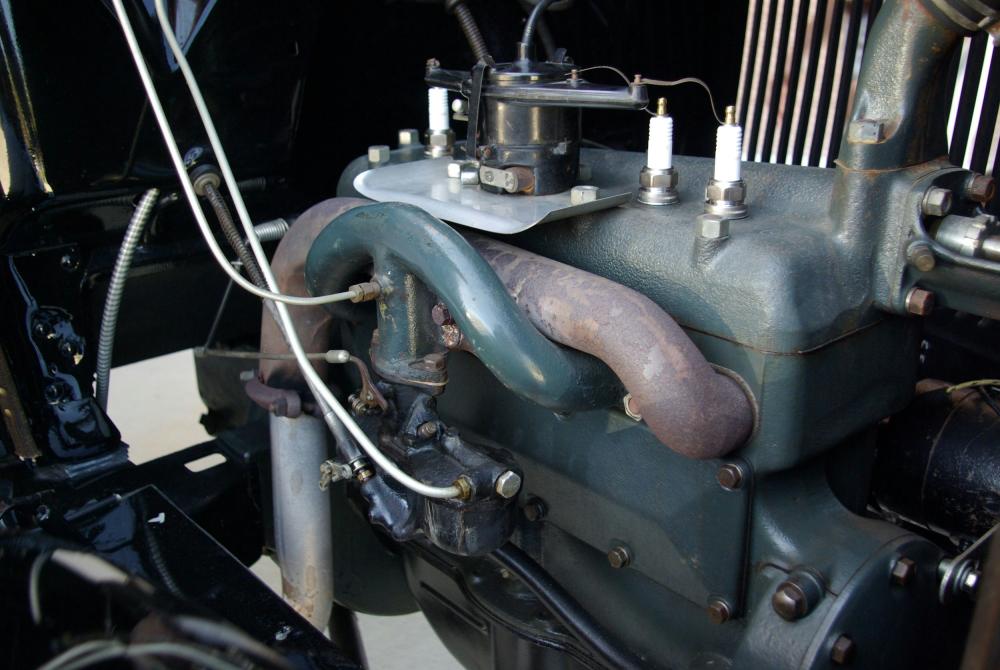
(Ford 201-cu.in. inline four-cylinder engine)
The Ford Model AA has a four-speed manual gearbox. The transmission is geared lower than the Ford Model A to provide more torque to move a loaded truck. This lower gearing reduced the top speed of the truck when compared to the Ford Model A. The transmission also featured a lock-out on the shift knob for reverse that required a lever to be activated with the thumb so reverse could be engaged. This was done to prevent accidental engagement of reverse while the truck was in motion. Early trucks had a worm gear rear-end that limited the top speed of the truck. That rear-end was replaced by a ring and pinion differential to improve the speed of the truck. Later models were fitted with braces on the outer casing of the rear-end to provide additional support to the rear-end housing.
The suspension of the Model AA Truck was similar to the Model A Ford in the front end. A leaf spring is centered in the front ‘A’ frame over the front axle. Shock absorbers were available for the front end. The rear suspension differed from the Ford Model A. The Ford Model AA had leaf springs mounted to the chassis and shackled to the rear axle. The rear suspension did not have shocks.
The controls in the Model AA are entirely mechanical, except the windshield wipers in later models. The brakes are mechanical and the truck has four oversized drum brakes to stop the vehicle. The mechanical system is a pull lever system that applies the force from the pedal to a pivot that pulls the brake rods that expand the brakes in the drums. The brake light is activated when the brake pedal is pushed. The brakes are proportioned more toward the rear drums. The parking brake is a chrome lever on the floor with a release button on the top. The windshield wipers started as hand operated and later models were powered by vacuum diverted from the intake manifold. The horn button is mounted in the middle of the steering wheel assembly. Controls for the lights are also incorporated into the steering assembly. The switch was a three-stop switch for parking lights, headlights and high-beams. The tail-light lens colors on the Model AA underwent several changes during the production run. Two levers are mounted on the steering column to adjust the engine. The left lever controls the manual advance of the timing. Adjusting the timing of the engine changes the time that a spark will occur in the combustion chamber and those changes affect the performance of the engine. The right lever is a manual control for the throttle. The throttle can be adjusted to ease the shifting of the transmission and the idling speed of the engine. Underneath the dash on the right side is the choke rod. The choke can adjust the flow of fuel from the carburetor into the engine. Turning the knob on the choke rod clockwise closes the fuel flow, leaning out the engine; turning the knob counterclockwise opens the fuel flow to the engine.
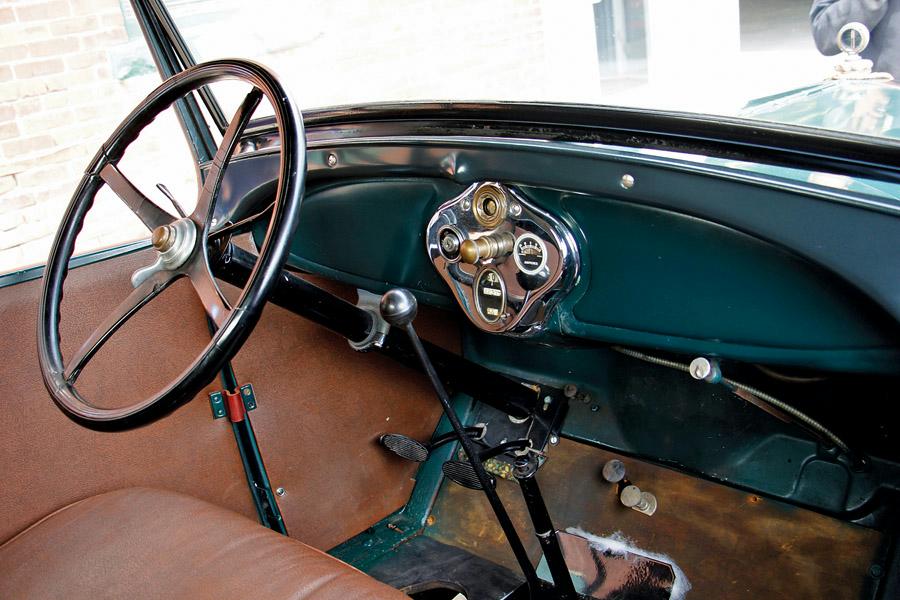
The gauge cluster includes three basic gauges. The cluster is in a diamond formation, with the start key and pop-out locking switch is on the left point. The top of the cluster holds the gas gauge, which directly connects into the gas tank, behind the dashboard. The right point holds the amp gauge, which shows the charge rate of the generator. The bottom of the dash holds the speedometer and odometer. Additional gauges can be mounted below the cluster if desired.
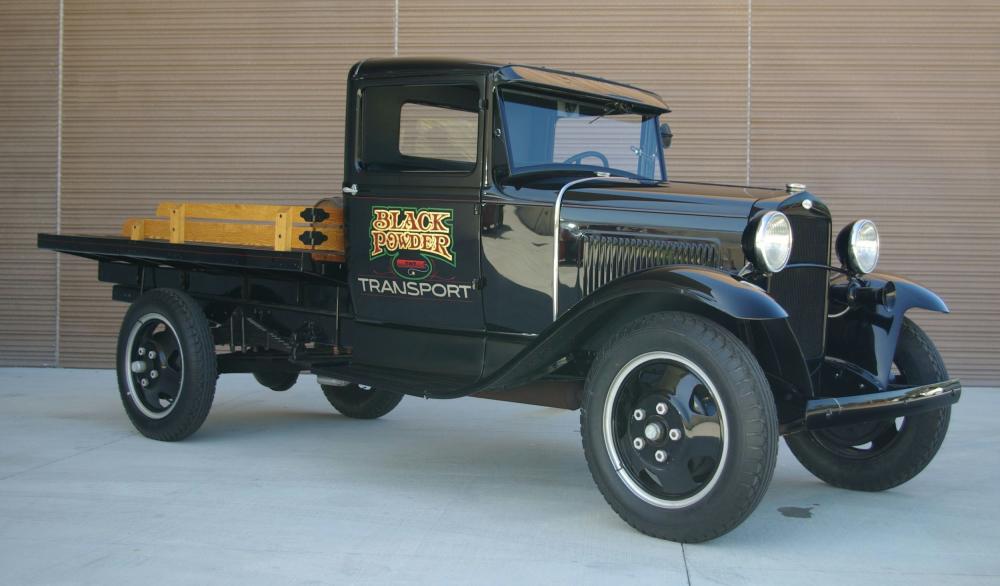
(1930 Ford Model AA flatbed)
During the production of the Model AA, the wheels were also changed. Spoked wheels similar in appearance to Model A wheels but much heavier were used during 1928–1929. Twenty inch 6 slot disc wheels were produced by Budd for Ford. In 1930, a new style 20-inch 5 slot disc wheel was adopted. These wheels were used for 1930 and part of 1931. The final wheels were a further modification of the 1930 wheel, with a raised center to reinforce the wheels and allow spacing of dual wheels in the rear so the tires would not rub against each other. The dual wheels were used for a variety of body styles, including dump trucks, tow trucks, tankers, fire trucks, and flatbed stake trucks. Wheel nuts changed with each new style of wheel to meet the changes made in the designs of the wheel. Special wheels were produced for ambulances, buses, and funeral coaches (hearses).
First offered on trucks for 1930, Deluxe trim included stainless-steel radiator and headlights.
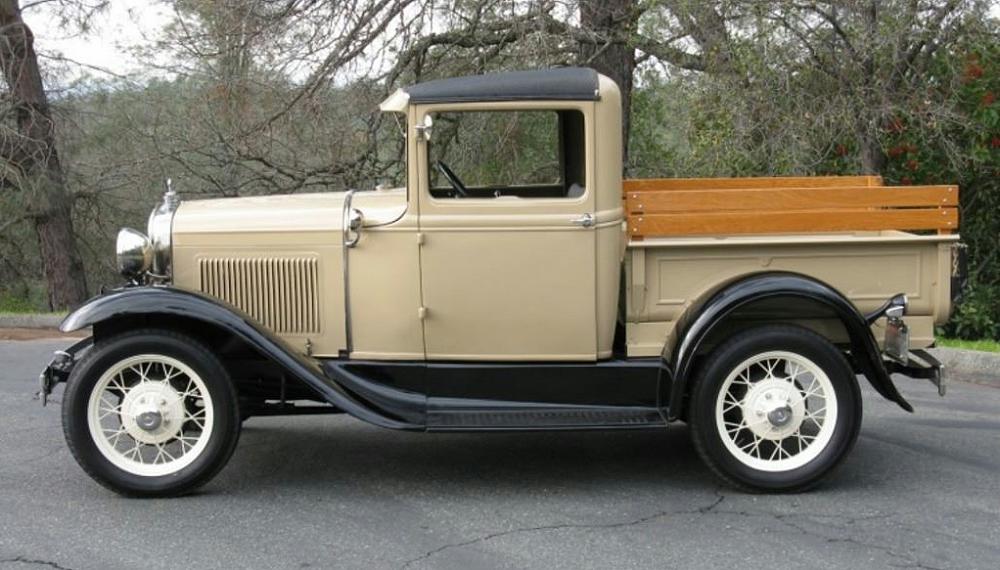
(1930 Ford Model A pickup)
The Ford Model AA was also used in a ‘tractor-trailer’ setup as shown in the photo below. These trucks were likely modified by an outside company.
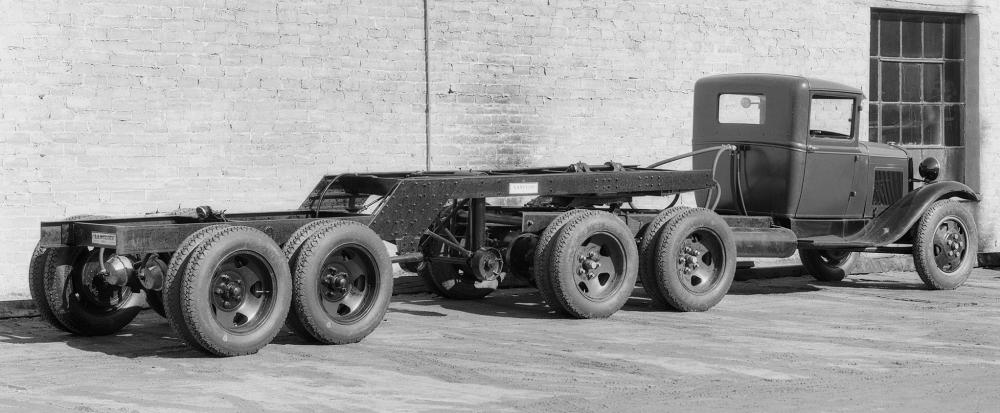
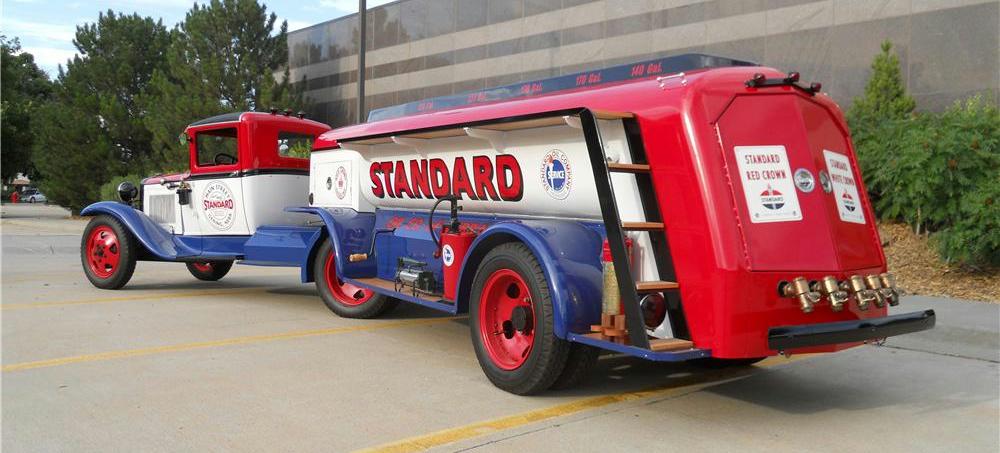
1932-1934 Ford Model B and Model BB Trucks
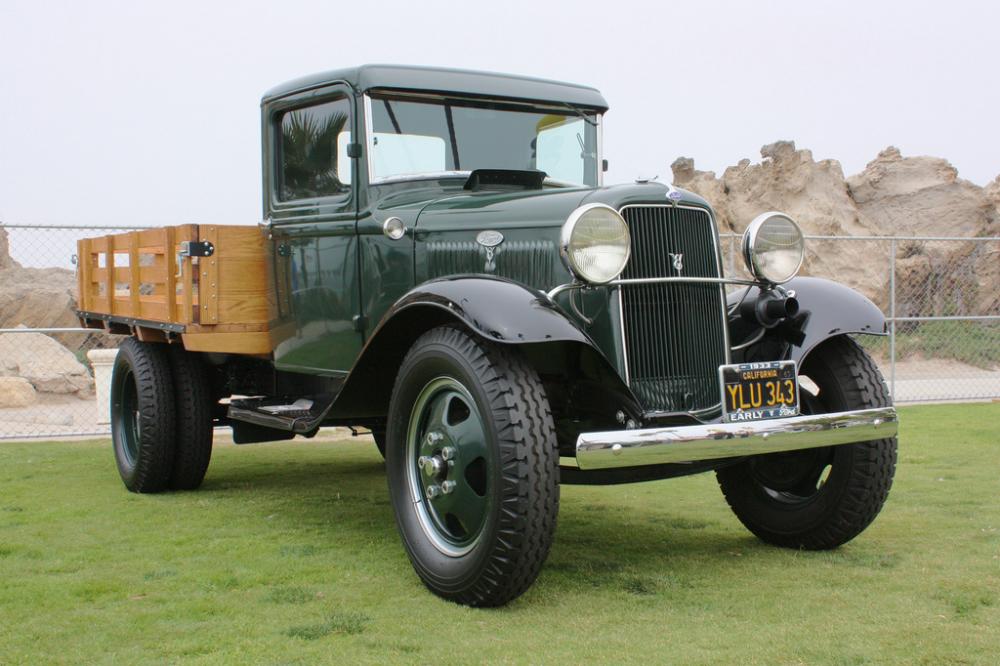
As with the previous Ford Model A, there were heavier commercial vehicles (1 or 1-1/2 ton models). They were available with either the venerable four cylinder or the more powerful 221 C.I.D. flathead V8.
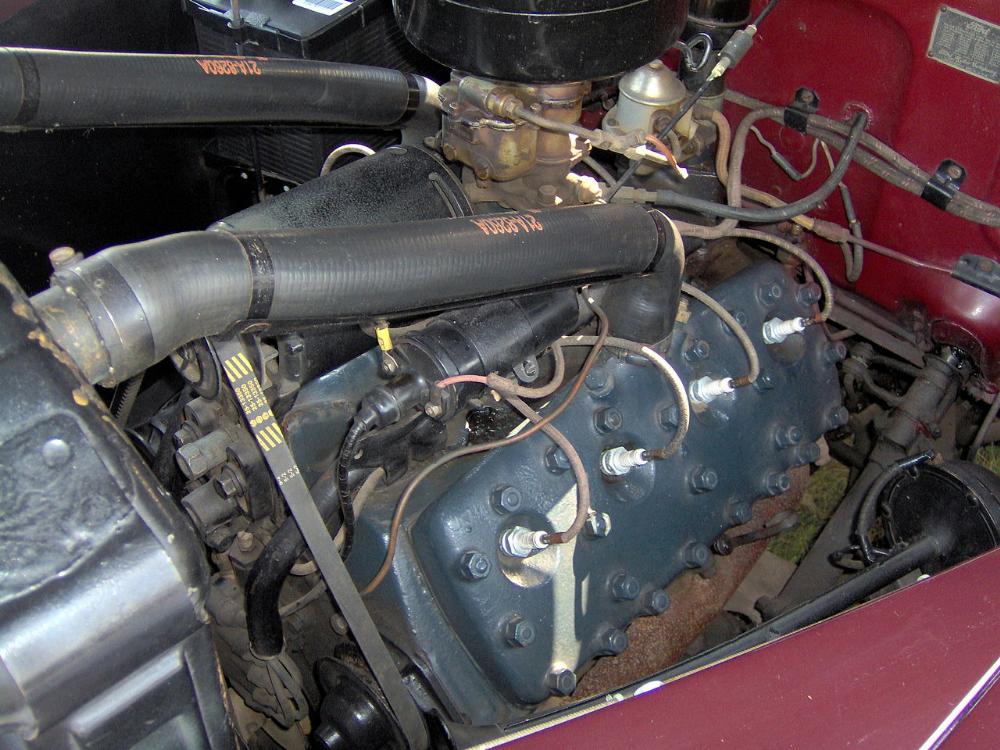
(Ford 221 CID Flathead V8)
The Ford Model BB had longer wheelbases of 131.5 or 157 in. (3340 or 3988 mm), a reinforced frame, heavy duty transmissions and axles, and bigger wheels. Wire wheels were standard on the light duty cars, the heavier got steel wheels (some of them dual on the rear axle). There was a separate catalog offering popular body styles, rolling chassis or chassis and cab. Many local coach builders offered their coachwork to customers in need of more specific solutions. During the Depression, also ambulances, hearses, or fire trucks found their way to budget-minded communities and organizations.
The V8 was strictly an option, even for heavy trucks. The bulk of these vehicles came with four cylinder engines. These trucks are easily mistaken for Model B or V8 commercial cars built on the passenger car chassis. Sedan deliveries, pickups, and station wagons were the best remembered of these. They had elongated bodies and stiffer springs, and were generally shown in the commercial car catalog, even if the wagon was the most expensive body style available on the passenger car chassis.
1934 Ford Trucks
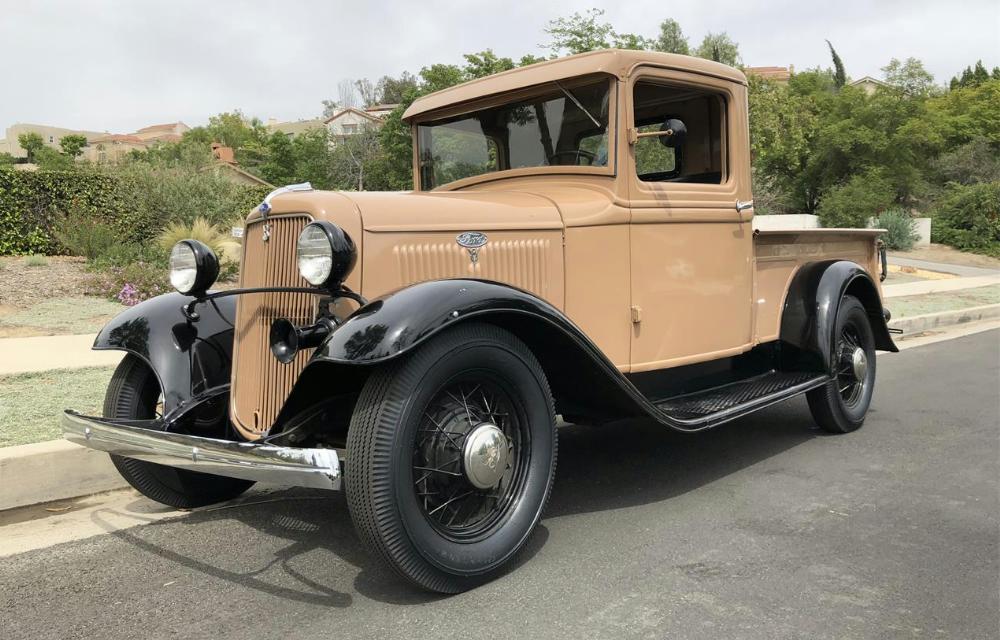
Due to low demand, 1934 was the last year not only for the four-cylinder engine, but also for open-cab Ford trucks. Since both of these represented the least-expensive alternatives, it was a subtle signal that the economy was finally beginning to improve.
Ford trucks didn’t share the car line’s sleek 1933 styling alterations, but did get a thicker grille housing and lower headlight bar, as shown on this little-changed 1934 pickup.
Ford’s V8 had grown so popular that the four-cylinder engine was fazed out during the model year, as was the roadsterlike Open Cab body for trucks.
The Ford Model BB chassis saw varied uses, as evidenced by this 1934 school bus.
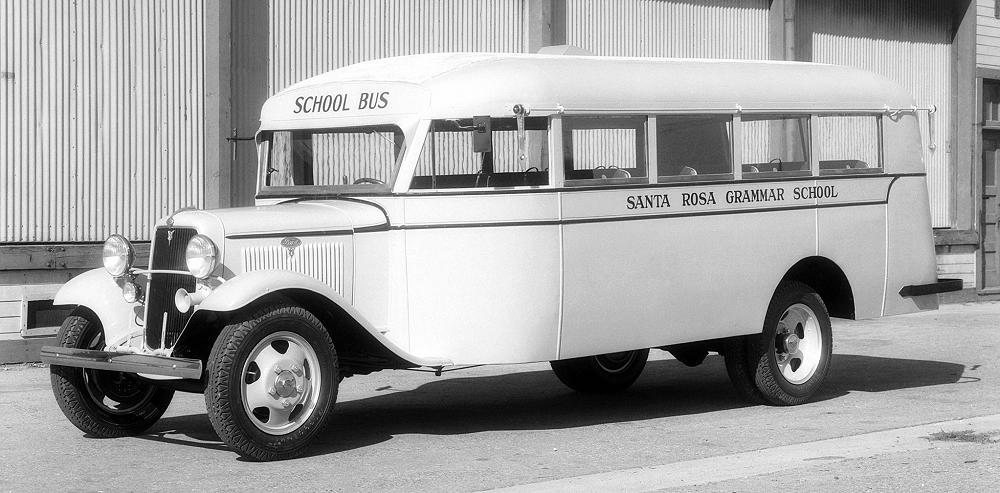
1935-1936 Ford Trucks
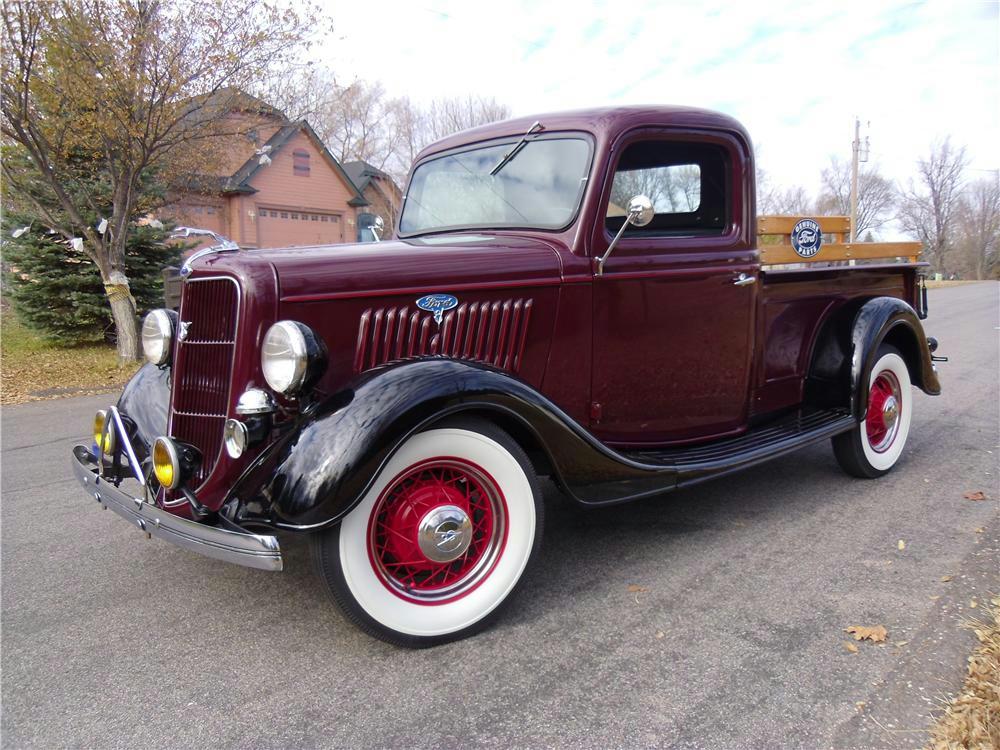
(1935 Ford Pickup)
A 1935 redesign for the Ford truck line brought a more curvaceous grille, skirted fenders, and laid-back windshield, which left them closer in appearance to contemporary Ford cars.
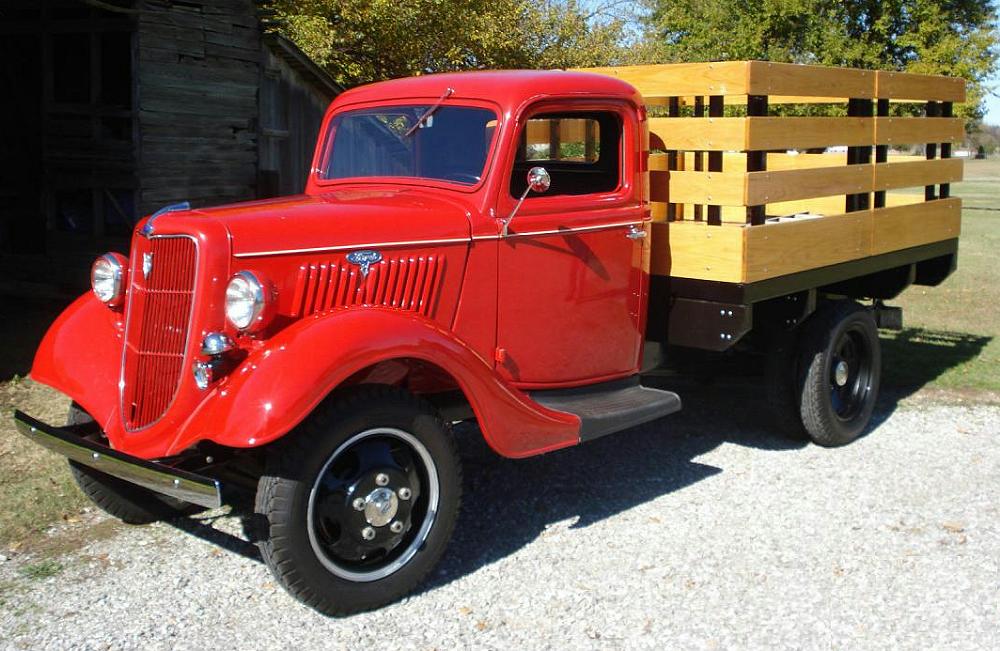
(1935 Ford 1-1/2 Ton Truck)
1937 Ford Trucks
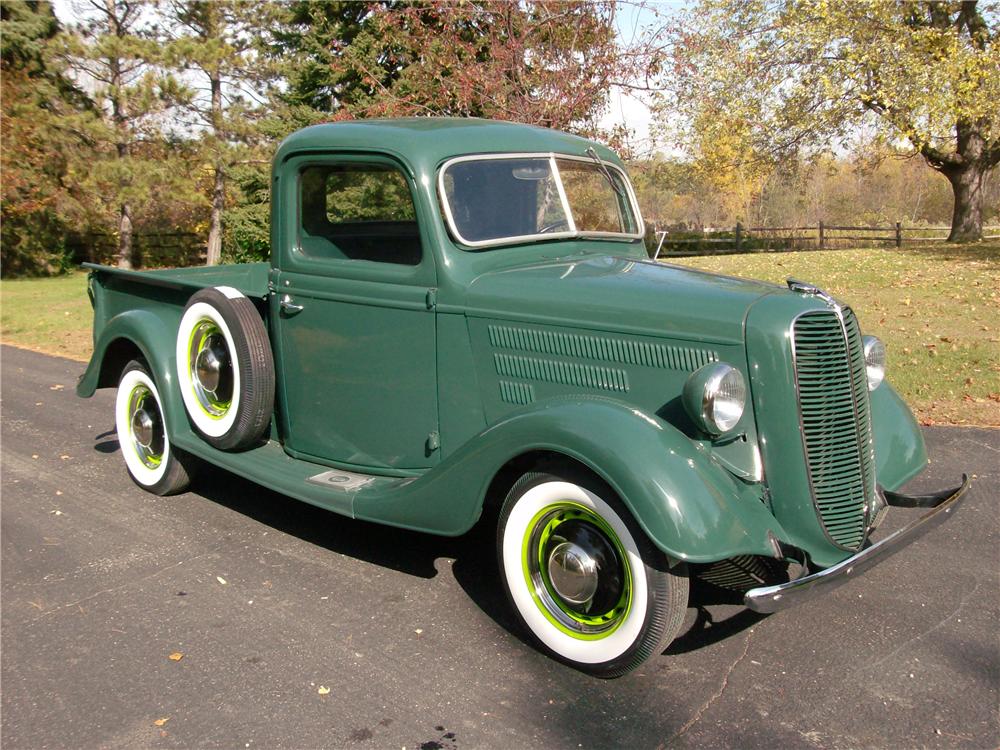
(1937 Ford Pickup)
All 1937 pickups had a V-8 engine — along with the appropriate badge on the side of the hood — but newly offered that year was a 136-cubic-inch 60-horsepower version that promised better fuel economy than its bigger 221-cid 85-hp brother.
Trucks got a fuller grille and vee’d windshield for 1937, but didn’t look anywhere near as modern as the car line. The interiors of 1937 Ford trucks didn’t match the new styling on the Ford cars of the same year.
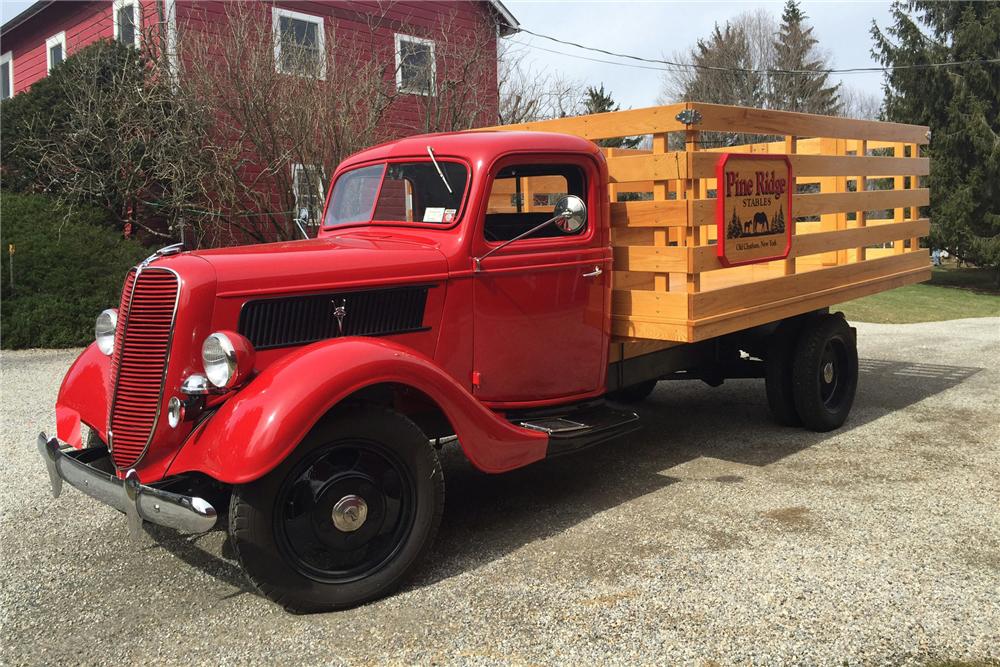
(1937 Ford 1-1/2 Ton Truck)
1938 Ford Trucks
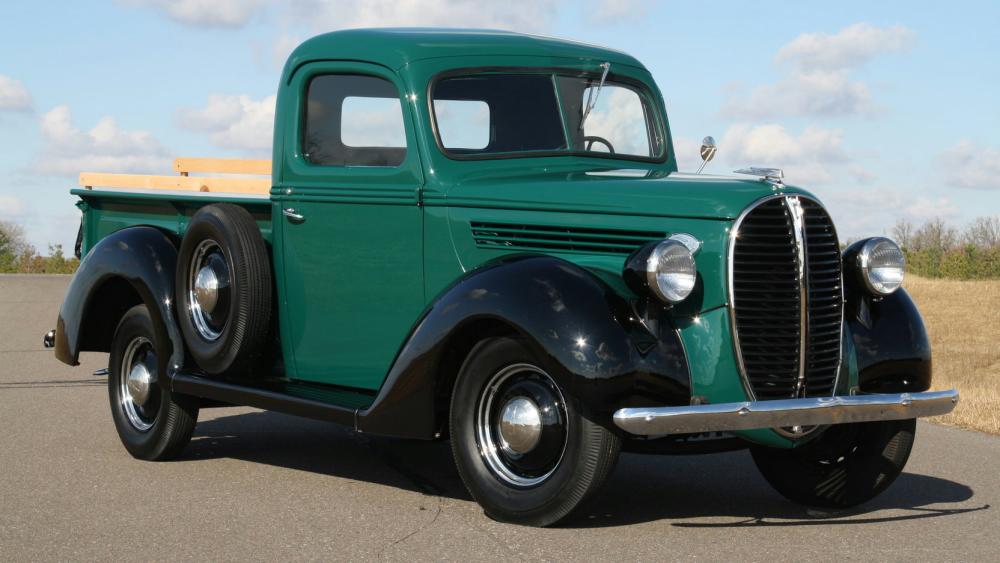
(1938 Ford Pickup)
Ford pickup trucks were fitted with a new cab, front-end sheetmetal, and bed for 1938, while 1-1/2 ton versions got a new chassis.
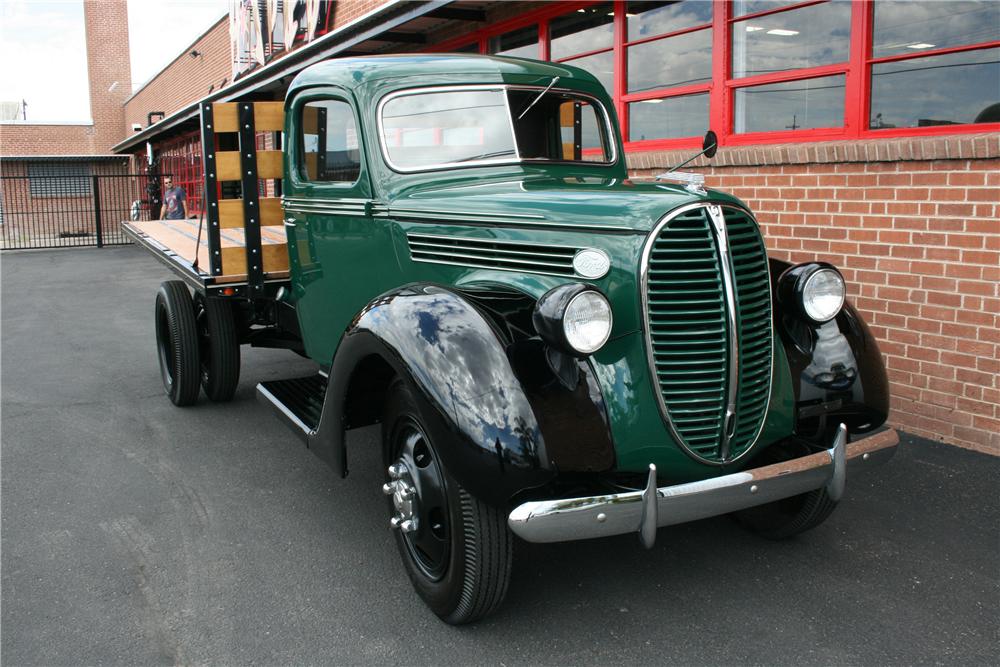
(1938 1-1/2 Ton Ford Truck)
A further attraction was the debut of a truck that slotted between the light-duty car-based pickup and the heavy-duty 1-1/2 ton models. Rated at one ton, the new series was appropriately called the “One-Tonner.” It would be followed by a Three-Quarter Tonner the following year. Also introduced by Ford in 1938 were the industry’s first Cab-Over-Engine (COE) models.
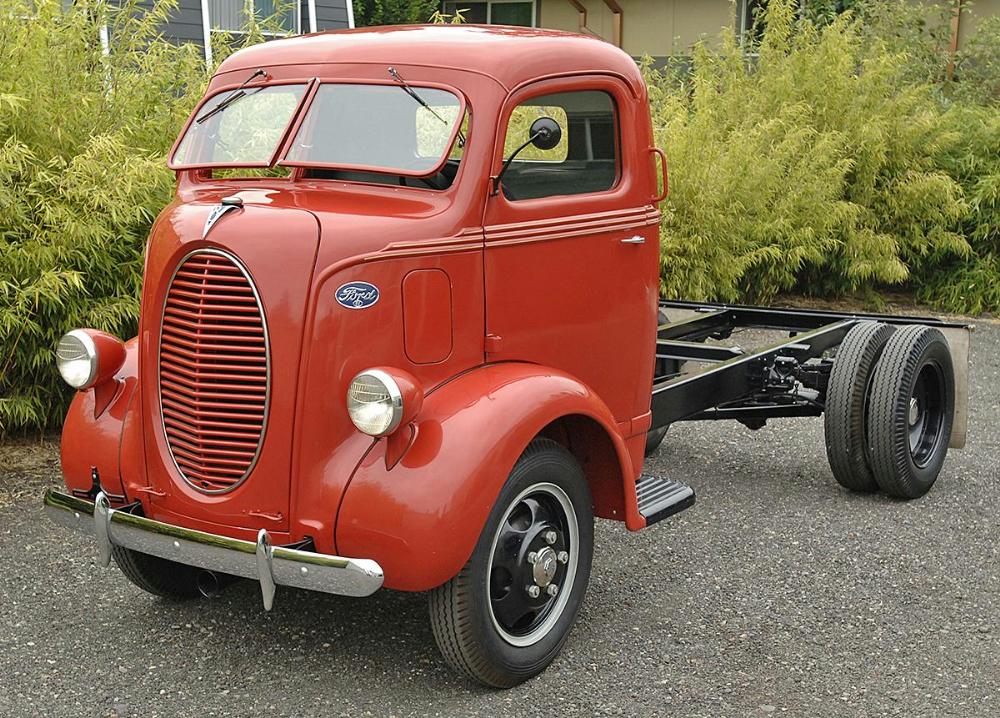
(1938 Ford COE)
1939 Ford Trucks
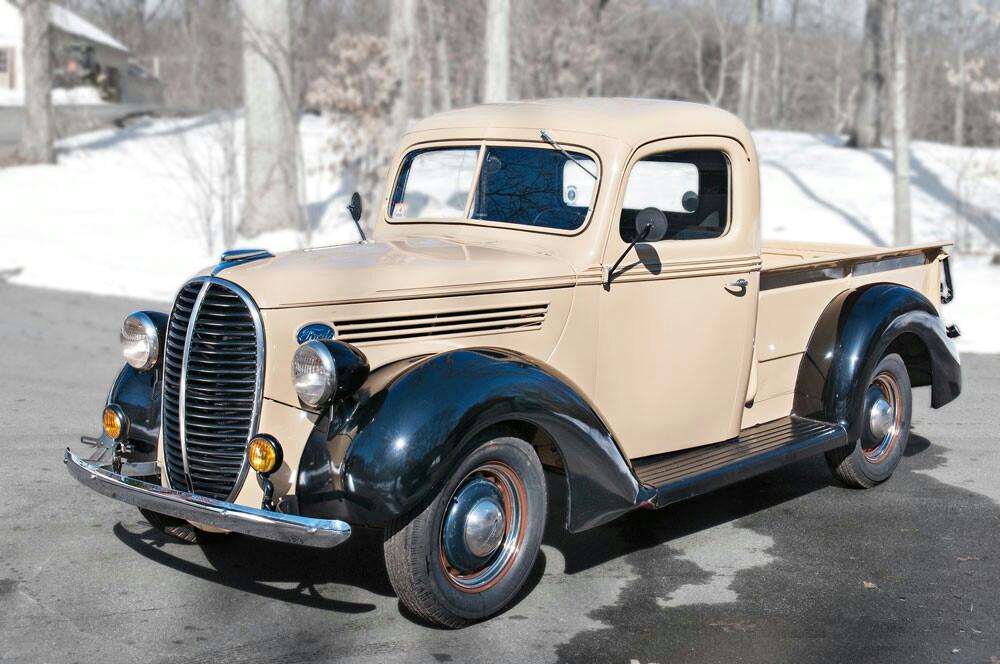
Though it looked little different than its 1938 counterpart, the 1939 Ford pickup boasts the unseen advantage of hydraulic brakes. Most competitors had adopted them years before, but Henry Ford had steadfastly stuck with the old mechanically actuated brakes until public and dealer pressure forced his hand.
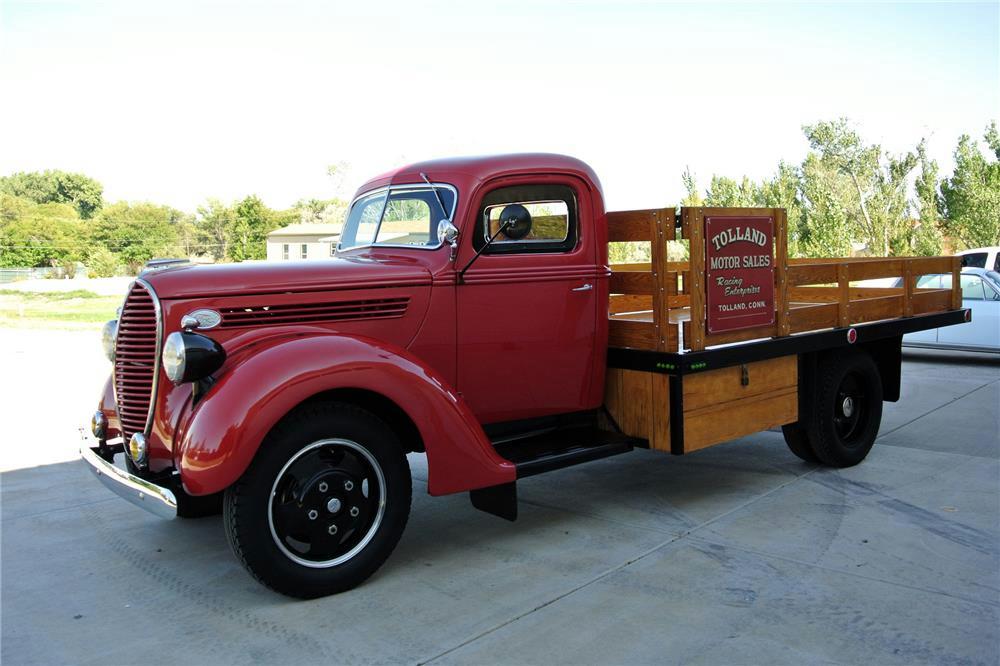
(1939 1-1/2 Ton Ford Truck)
1939 saw the introduction of the Ford 3/4 ton truck.
1940 Ford Trucks
Ford trucks were updated in 1940 as 1/2-ton trucks took on car styling for the first time in almost 10 years. Ford also produced its 28-millionth vehicle in 1940.
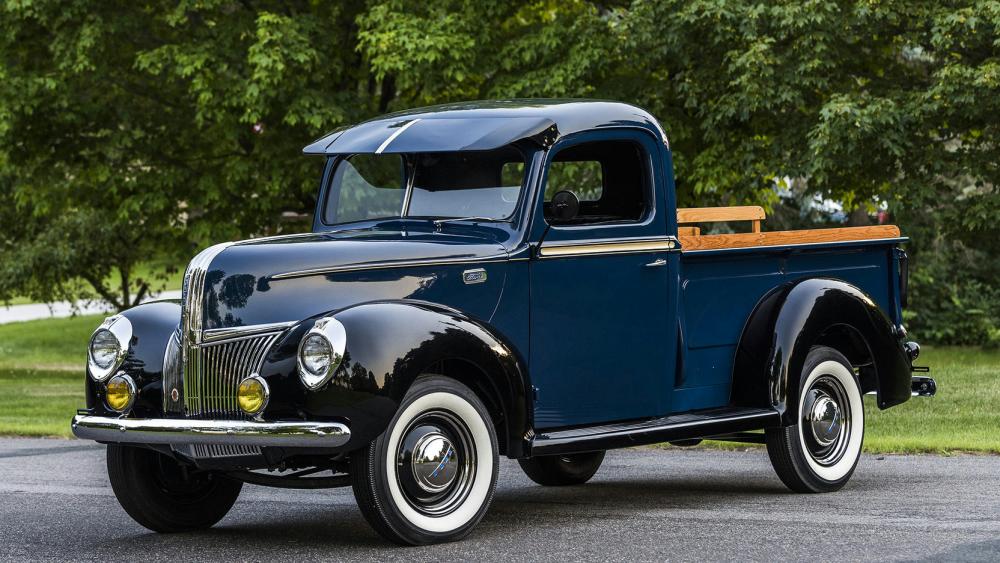
(1940 Ford 1/2-Ton Pickup)
For 1940, 1/2-ton pickups adopted the look of that year’s Standard-series cars — the first time since 1932 that trucks shared car styling. This included a vee’d grille, pointed hood, and headlights mounted into the fenders, giving these haulers a modern, classy look. Power continued to come from a choice of two flathead V-8 engines: a 136-cubic-inch 60-horsepower unit, or a 221-cid 85-hp version.
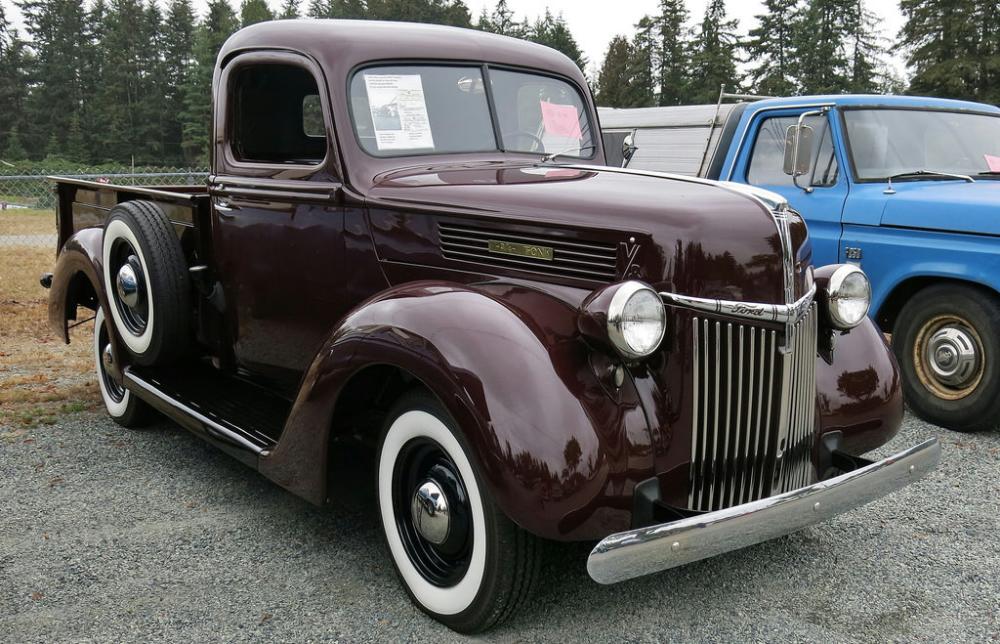
(1940 Ford 3/4 Ton Truck)
1941 Ford Trucks
Conventional heavy-duty trucks retained the previous year’s styling, as shown on this 1941 Ford Stake Bed (below). Note that all heavy-duty models retained freestanding headlights.
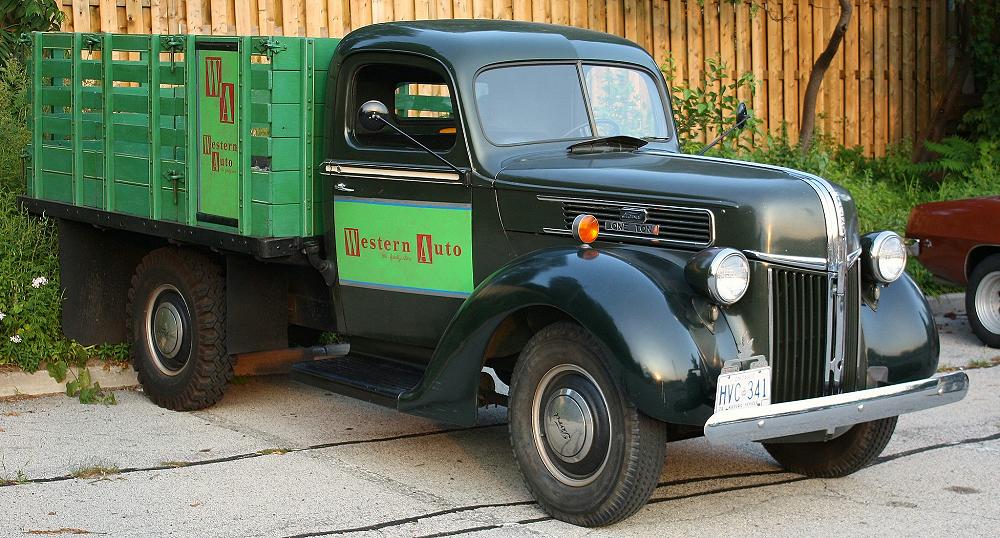
(1941 Ford one ton truck)
Ford-powered tractor-trailer rigs appeared in the late 1920s, and by the early Forties, were capable of pulling two heavily loaded trailers.
The big news for Ford trucks in 1941 was the availability of a new six-cylinder engine option to augment Ford’s flathead V-8. The six had more torque than the V-8 and provided somewhat better fuel economy. And for those really interested in economy, also offered on some light- and medium-duty trucks during this period was a four-cylinder engine based on that of the company’s farm tractor.
1942 Ford Trucks
Ford trucks boasted new styling for 1942, but relatively few were built.
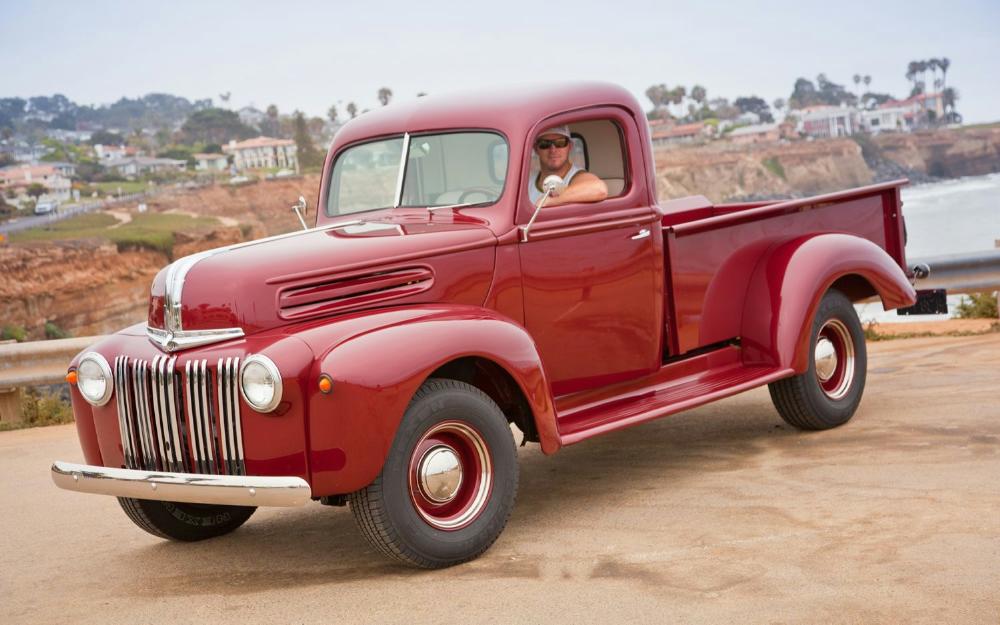
(1942 Ford Pickup)
Production ceased on February 10, 1942, so the Ford company could concentrate on building war material instead.
1945 Ford Trucks
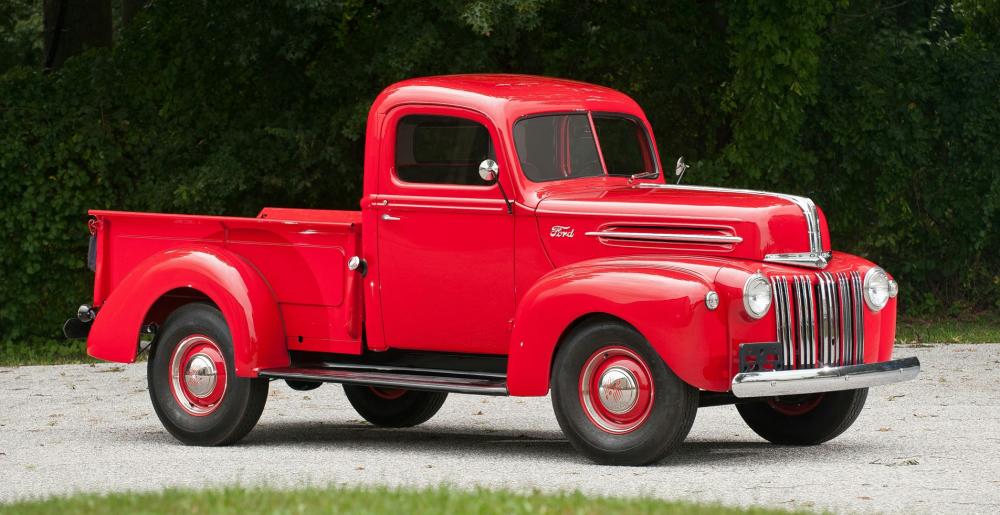
With demand for war-related vehicles easing toward the end of 1944, the War Production Board authorized Ford to resume production of a limited run of heavy-duty trucks for the civilian market. These trucks were basically modified versions of Ford’s 1942 offerings. In order to be able to buy one, purchasers had to prove their business was vital to the war effort.
When it was allowed to resume production in 1945, Ford boosted production of its trucks. Ford took this cue to boost production of its heavy-duty trucks, which were introduced in May of that year. Though they looked like Ford’s 1942 models, they were treated to a number of modifications, including an improved V-8 engine.
1946-1947 Ford Trucks
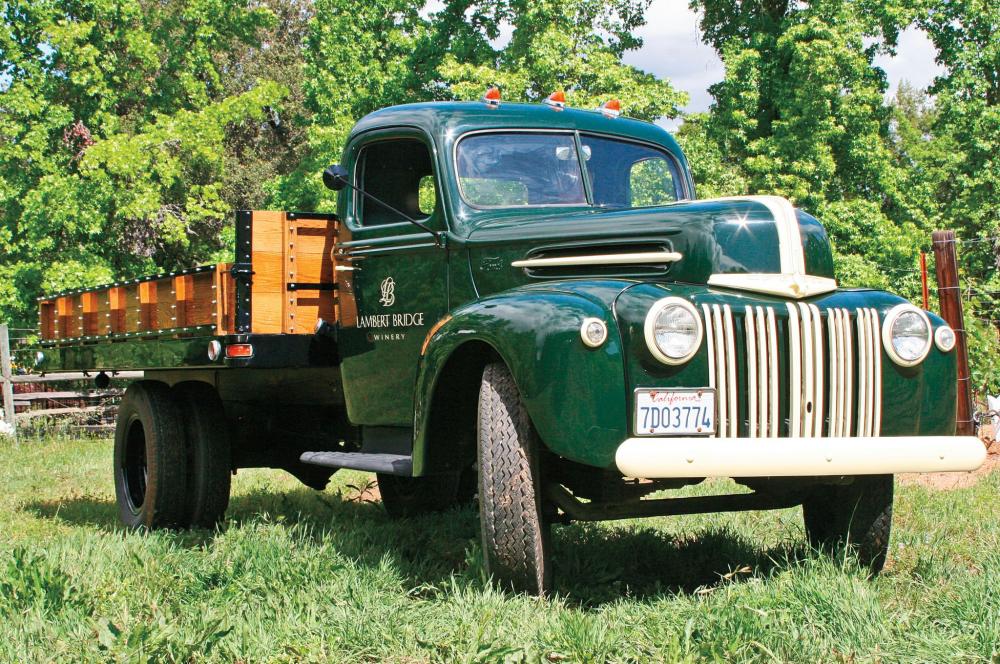
(1946 one-ton Ford truck, which was now referred to by the factory as a “Tonner”)
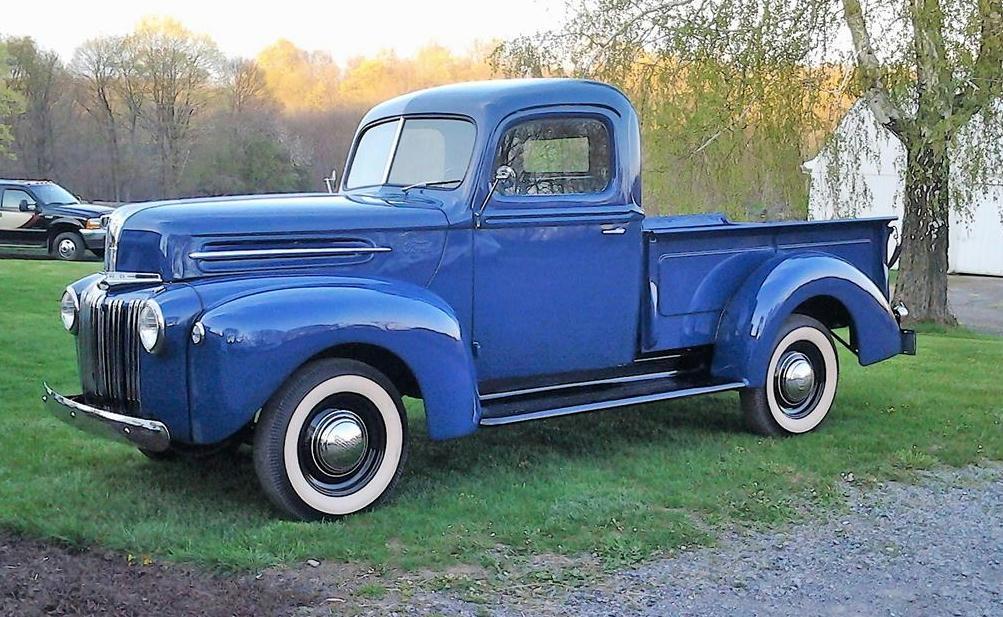
(1946 Ford Pickup)
This 1946 1/2-ton pickup, now called a “Half-Ton” by Ford, is also tire-less due to post-war rubber shortages.
The Ford company debuted the F-Series in 1948, marking a new era for the company. Check out ‘History of The Ford F-Series‘.
